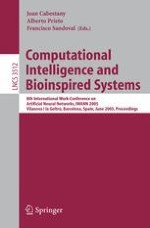We present in this volume the collection of finally accepted papers of the eighth edition of the “IWANN” conference (“International Work-Conference on Artificial Neural Networks”). This biennial meeting focuses on the foundations, theory, models and applications of systems inspired by nature (neural networks, fuzzy logic and evolutionary systems). Since the first edition of IWANN in Granada (LNCS 540, 1991), the Artificial Neural Network (ANN) community, and the domain itself, have matured and evolved. Under the ANN banner we find a very heterogeneous scenario with a main interest and objective: to better understand nature and beings for the correct elaboration of theories, models and new algorithms. For scientists, engineers and professionals working in the area, this is a very good way to get solid and competitive applications. We are facing a real revolution with the emergence of embedded intelligence in many artificial systems (systems covering diverse fields: industry, domotics, leisure, healthcare, … ). So we are convinced that an enormous amount of work must be, and should be, still done. Many pieces of the puzzle must be built and placed into their proper positions, offering us new and solid theories and models (necessary tools) for the application and praxis of these current paradigms. The above-mentioned concepts were the main reason for the subtitle of the IWANN 2005 edition: “Computational Intelligence and Bioinspired Systems.” The call for papers was launched several months ago, addressing the following topics: 1. Mathematical and theoretical methods in computational intelligence.
